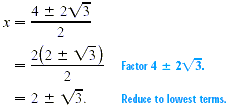|
Home |
Quadratic EquationsAn equation with 2 as the highest exponent of the variableis a
quadratic equation. A quadratic equation has the form ax The simplest way to solve a quadratic equation, but one that is not always applicable, is by factoring. This method depends on the zero-factor property. ZERO-FACTOR PROPERTY If a and b are real numbers, with ab = 0 then a = 0, b = 0 or both. Solving Quadratic EquationsEXAMPLE Solve 6r Solution First write the equation in standard form. 6r Now factor 6r (3r - 1)(2r + 3) = 0 By the zero-factor property, the product (3r - 1)(2r + 3) can equal 0 if and only if 3r - 1 = 0 or 2r + 3 = 0 Solve each of these equations separately to find that the solutions are 1/3 and -3/2. Check these solutions by substituting them in the original equation. CAUTION Remember, the zero-factor property requires that the product oftwo (or more) factors be equal to zero, not some other quantity. It would beincorrect to use the zero-factor property with an equation in the form (x + 3)(x - 1) = 4 for example. If a quadratic equation cannot be solved easily by factoring, use the quadratic formula. (The derivation of the quadratic formula is given in most algebra books.) QUADRATIC FORMULA The solutions of the quadratic equation ax
EXAMPLE Solve x Solution The equation is already in standard form (it has 0 alone on one side of the equals sign), so the values of a, b, and c from the quadratic formula are easily identified. The coefficient of the squared term gives the value of a; here a = -1. Also b = -4 and c = -5 (Be careful to use the correct signs.) Substitute thesevalues into the quadratic formula.
The
The two solutions are 5 and -1. CAUTION Notice in the quadratic formula that the square root is added to orsubtracted from the value of -b before dividing by 2a. EXAMPLE Solve x Solution First, add -4x on both sides of the equals sign in order to get the equationin standard form. x Now identify the letters a, b, and c. Here a = 1, b = -4, and c = 1. Substitute these numbers into the quadratic formula.
Simplify the solutions by writing
The two solutions are The exact values of the solutions are
NOTE Sometimes the quadratic formula will
give a result with a negative number under the radical sign, such
as *The symbol |




